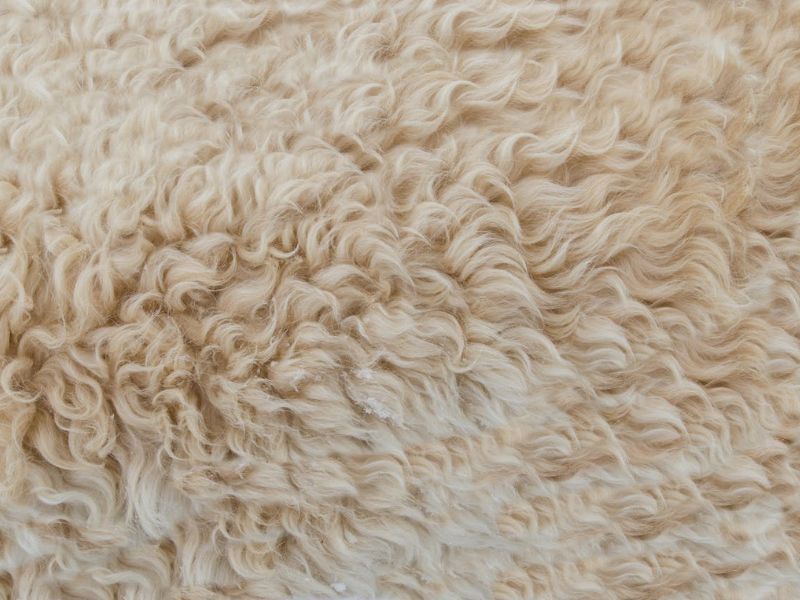Differences Between Wool and Hair
The main difference between wool and hair is the texture of the material, since hair maintains a smooth consistency and is softer to the touch while wool is a curly material.
Even at a biological level, the differences between both elements that make up the coat of certain animals are evident. For example, when wool grows it forms fleeces that are accumulations or balls of fiber, while hair falls loose.
Understanding these differences is very relevant because it helps decipher the treatment that must be maintained with the animals that produce this type of natural fibers. Likewise, in this article we show you a wide variety of data of interest in the textile industry.
CHARACTERISTICS OF WOOL
To facilitate understanding of the key differences between wool and hair, it is essential to understand both concepts and the properties they maintain individually. As for wool, it is a composition of simple synthetic fibers.
Wool is formed through the production of natural hair follicles that have excellent elasticity and precisely this characteristic makes it a material capable of being reused.
In fact, this material tolerates contact with water quite well when it is rinsed for use. Although an important characteristic is that when it grows and is not pruned in time, it can curl so much to the point of breaking or affecting its quality.
Greater moisture and heat retention
One of the properties of wool that stands out the most is its ability to absorb moisture, this occurs as a reaction of the material to the presence of water.
Basically, water does not adhere to the material but is introduced as vapor, becoming part of the fiber structure. Thanks to this, garments made of wool have a great thermodynamic capacity, making them feasible as outerwear.
Moisture retention in textiles is a highly relevant issue in the manufacture of garments designed with thermal qualities. In addition, wool also stands out as a powerful temperature insulator.
It is easy to think that this material, when used in a hot and dry environment, can generate more heat. You may be surprised to know that this is not the case, since wool loses water vapor to the environment and manages to absorb heat, generating a feeling of freshness.
Elastic and soft material
In the textile industry and selection of materials, elastic capacity is highly valued, and in this aspect wool manages to differentiate itself as a reference.
Its elasticity allows it to be a fairly versatile material and can be used in the production of various garments or even decorative elements such as rugs.
Wool fibers can stretch almost twice their size, and in terms of elongation it is also a material that stands out because it can shrink three times more.
Basically, the material manages to adapt to multiple shapes without breaking, thanks to this it has been widely integrated into everyday life, in the form of everyday objects, accessories and in sustainable fashion.
Distinguished quality for long-lasting textile elements
It is one of the most relevant points when analyzing the key differences between wool and hair, since wool is a material that ensures long life. Garments made with this base usually have a long useful life.
But quality not only has to do with the fact that it is a versatile, adaptable material capable of stretching without affecting its shape or its excellent qualities, but it also has to do with its ability to prolong dye retention.
The color in garments and other elements made with wool remains of almost unbeatable quality even if they were treated with natural textile dyeing.
The manufacture of articles made with wool stands out because its quality is capable of transcending, to always look like the first day. Very resistant coats, hats, gloves and even blankets are often made.
Prominent shine with an ideal aesthetic appearance
Another of the interesting properties of wool is that it is a material that projects a natural shine, this makes it an option with an impressive aesthetic quality. Dozens of prestigious brands have used its uses in multiple clothing items.
Even within sustainability projects in fashion, wool has been used to a great extent for conscious reuse of the material, and this has to do with its capacity for resistance, durability and dyeing quality.
Wool thermal insulation
This material has a great thermal capacity and this is explained in the constitution of the fibers, as they are more curly and have prominent elasticity. Thanks to this, air retention occurs that improves body freshness.
On the other hand, garments made with this material do not usually adjust to the body to be tight and this also gives up a layer of air that increases its capacity as a thermal insulator.
HAIR CHARACTERISTICS
In order to carefully analyze the key differences between wool and fur, you need to know the distinctive details of both materials. In this sense, the following properties of hair and its use in the textile industry stand out.
The cuticle is regular and smooth
The hair cuticle comes from natural fibers, and is characterized by being straight and having a regular texture. This causes the material to have a lower capacity to retain moisture or heat.Therefore, clothing made from camel or other animal hair does not maintain great moisture or heat retention, being a differentiating feature in terms of the properties of wool.
The material is less soft
Although clothing and other items made from fur may feel delicate to the touch, they do not feel as soft as wool. And this is due to the fact that the elasticity is reduced and the sides are smoother.
When stretching this type of material, its resistance is limited; even if it is treated inadequately compared to its properties, it could break. This is why hair in the textile industry is usually mixed with other materials such as wool.
Growth is limited
Biologically, the growth between both materials is different, in the case of hair it tends to be limited because once it reaches its maximum length it detaches from the cuticle.
For this reason, producers must remain attentive to the stages of development of the strands to obtain the natural fiber at its best and avoid shedding that threatens quality.
Temporary retention of the dye
One of the key differences between wool and fur is the retention capacity of artificial or natural dye. Hair is a material that retains dye for less time because its reaction to humidity is less compared to wool.
This means that garments made only with hair as a fiber of animal origin have an aesthetic quality that decreases over time. In some cases you even have to repeat the pigmentation process.
Tipos de pelo y sus usos en la industria
Although wool is an extremely versatile material and its application stands out in multiple creations, hair is also a widely used material in the textile industry due to the variety of sources of animal origin from which it is extracted.
Below, I present some types and characteristics of the hair most used for fabric composition:
- Alpaca: comes from the alpaca, its production is quite common in South America, mainly in the Andean region. It differs from wool by its longer and shiny constitution, it is flexible but not as elastic.
- Angora: It is characterized by having abundantly growing hair, very fine and quite soft to the touch, it comes from a type of rabbit native to the Angora region. It is often mixed with cotton to have a quality material.
- Guanaco: it is obtained from the fur of an animal similar to the vicuña, it is a fine and very soft material, it is often used in the textile industry in the high-end sector for the production of coats and other warm clothing.
COMPARISON BETWEEN WOOL AND HAIR
To better understand the key differences between wool and hair, I will leave you the following comparative table where you can see the distinctions established in both properties and textile uses.
| Characteristic | Wool | Hair |
|---|---|---|
| Marrow | Present in some fibers, it can be discontinuous or fragmented. | Generally present, more defined in thick and rigid hairs. |
| Cuticle | Scale structure that helps elasticity and maintains moisture. | Scale structure that varies in shape and size depending on the animal, important for protection and texture. |
| Diameter | It varies depending on the breed of sheep; some very fine (Merino), others thicker. | Varies widely; from very fine (cashmere) to thick (horse hair). |
| Sides | The grain can be more rounded or oval in shape, influencing how it feels. | It depends on the type of hair; It may be more round or irregular, affecting texture and use. |
| Growth | Continuous growth up to a certain length depending on the breed and health of the animal. | Continuous growth; Some hairs like human hair can grow indefinitely. |
| Glow | Naturally shiny, the wool can have a soft luster that enhances its color. | Brightness varies; some hairs are naturally shiny and others more matte. |
| Properties | Hydrophilic, fire resistant, thermal insulating, biodegradable and elastic. | Properties vary; Generally resistant, some fibers such as cashmere are exceptionally soft and insulating. |
CONCLUSION ON THE KEY DIFFERENCES BETWEEN WOOL AND HAIR
As can be seen, both materials have several key differences, such as the elasticity of textile fibers. Wool is a material that can stretch to twice its size without affecting its composition, something that is not possible with animal hair.
However, when assessing the care requirements for wool textiles, the degree of demand higher than that of hair is evident. So both materials have pros and cons, plus they have a prominent entry in the textile world thanks to their versatility.



Users Reviews